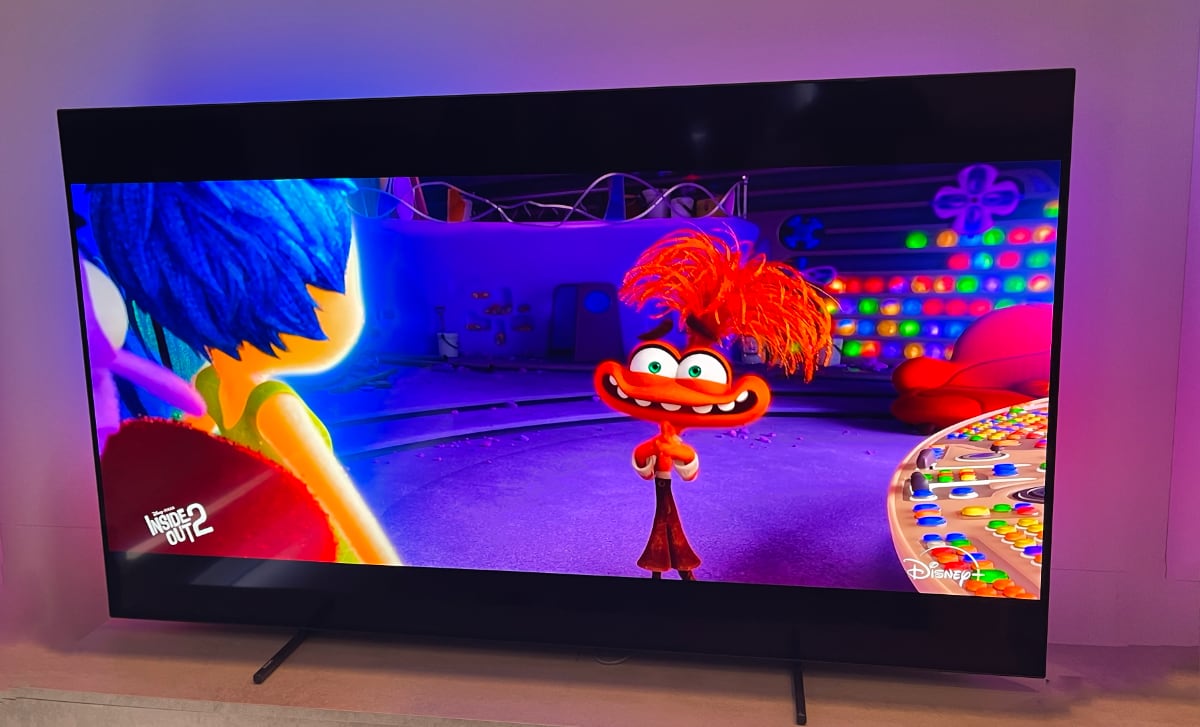The new 4-stack OLED panel in Philips OLED950 and OLED910 is not only brighter but also delivers significantly improved color. Here's FlatpanelsHD's first look at Philips' 2025 TVs.
In Barcelona, FlatpanelsHD got a first look at the new Philips TV line-up for 2025. Once again, Ambilight is in focus, with more 4-sided Ambilight models and another model featuring Ambilight Plus.
However, the biggest change in 2025 is undoubtedly the new 4-stack OLED panel, about which we received additional key details, along with a side-by-side comparison with last year's 2nd-generation MLA OLED panel.
4-stack OLED is brighter, better
FlatpanelsHD had the scoop on the significantly improved panel in December 2024 and it was formally announced in January. After rumors about two versions of MLA OLED last year, Philips's Danny Tack confirmed to FlatpanelsHD that only one version of each panel exists: both the MLA OLED and the new 4-stack OLED panel for 2025.
He also confirmed that while existing 2024 models with MLA OLED will continue to be sold in 2025, TV makers will no longer launch new models with MLA OLED, as the panel is being discontinued.
We wanted to clear up this confusion right away, as you may have seen the new 4-stack panel advertised with both 4000 and 3700 nits peak brightness. It is the same panel, and Philips, who cites 3700 nits, stated that it will look into whether it can push its TVs to the 4000 nits level, as specified by LG Display.
We should again emphasize that we do not expect these brightness levels to be reached in calibrated picture mode due to the lower color temperature than the panel's native, much cooler color temperature. It may be achievable in dynamic mode, which we will examine once we get our hands on a review sample.
Still, after seeing it in action, we have no doubt that the 4-stack panel is noticeably brighter, not just in small highlights but also across the screen as a whole, as full-screen brightness has been markedly improved. It was clear from the demos that the increased brightness will further solidify OLED technology's lead in HDR picture quality, whether WOLED or QD-OLED.
Improved color
A less talked about improvement in the 4-stack panel is the switch to the Primary RGB Tandem structure, which means that WOLED technology will for the first time have red, green and (two) blue emitting layers, along with 20% improved energy efficiency.
This will improve the color gamut of WOLED beyond DCI-P3 for the first time, to around 83% Rec.2020, meaning that WOLED will shrink the gap to QD-OLED's 90% Rec.2020.
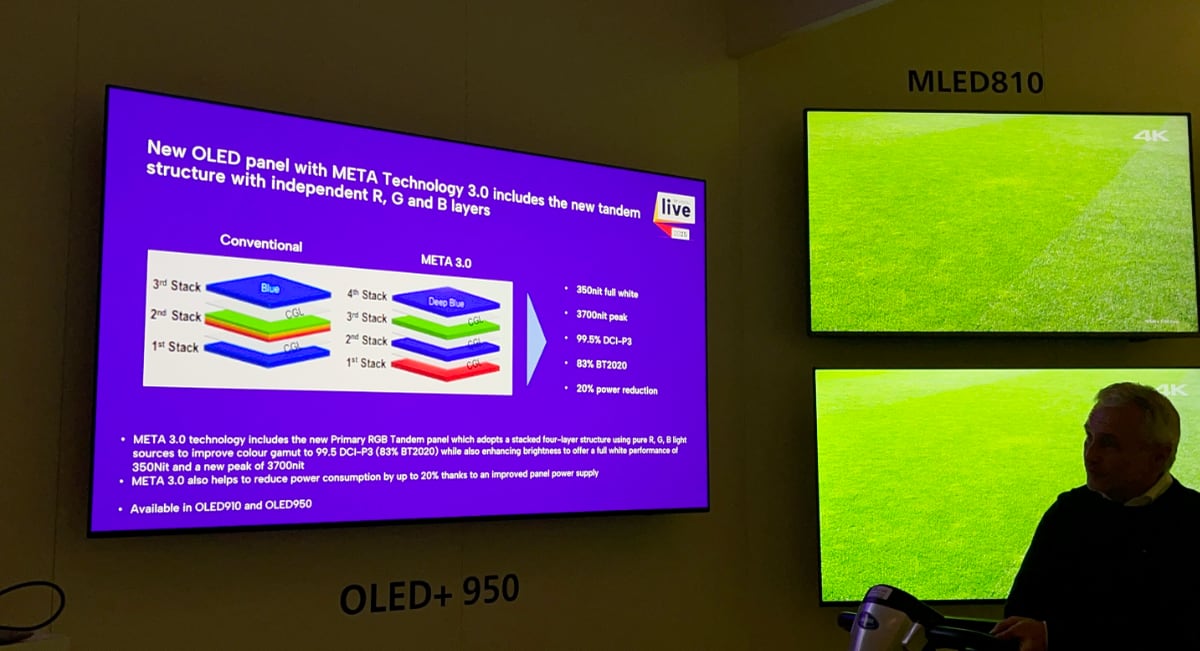
The 4-stack OLED panel introduces several picture quality improvements. Photo: FlatpanelsHD
There is still a white subpixel that will dilute color saturation somewhat at the very highest luminance levels, but the Primary RGB Tandem is a major jump to 2100 nits pure color brightness as compared to 1500 nits on 2nd-gen MLA OLED and just 500 nits of color brightness on the normal OLED panel used in most TV models.
The improvement in color was very evident from the demos we saw in Barcelona where Philips compared the 4-stack panel to last year's MLA OLED, with especially red and green saturation improved.
To enjoy the improved color you need HDR content, preferably mastered to color beyond DCI-P3 but the improved color saturation will also to some extend benefit HDR content mastered to DCI-P3.
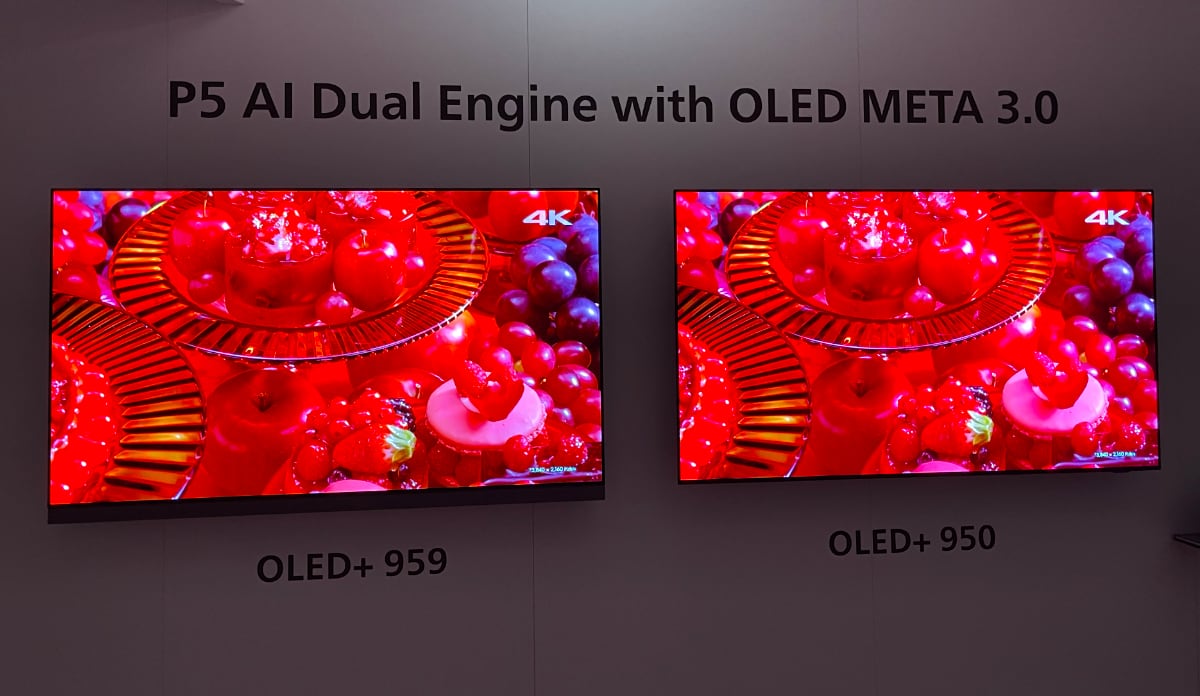
Impossible to capture in a photo, but the 4-stack OLED (right) delivers significantly more saturated primary colors. Photo: FlatpanelsHD
Improved brightness and color combined with a new version of the 'Vantablack' anti-reflection filter first implemented on MLA and now optimized for the 4-stack panel's emitting structure, results in a panel that can now maintain black in even bright environments – unlike MLA OLED's slightly grayish look. It represents a visible upgrade in OLED picture quality that we look forward to examining in more depth.
While unable to capture and show the improved brightness and color, our video below from Barcelona with Philips' picture guru, Danny Tack, should give you a general idea about what we saw during the side-by-side comparisons.
Danny Tack also confirmed to FlatpanelsHD that the cheaper OLED810 with get an improved OLED EX panel, with slightly higher peak brightness of up to 1500 nits, while the OLED760 will get the older OLED EX panel with up to 1000 nits peak brightness.
Philips' Danny Tack's deep-dive into 2025 OLED technology. Video: FlatpanelsHD
Artificial Intelligence and Android 14
A big theme for Philips is the use of Artificial Intelligence in TVs to improve picture, audio and Ambilight. This year, more of the picture enhancement algorithms have been trained on ML-trained algorithms, and a new 'Ambilight AI' feature has automatic scene detection and adaptation based on your room conditions.
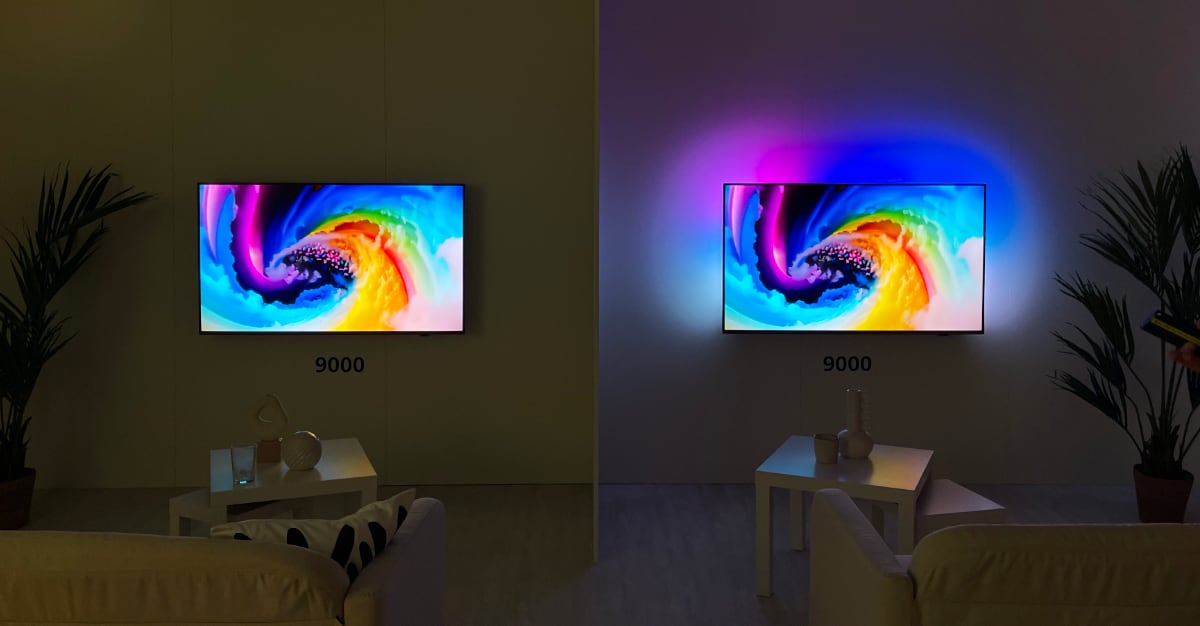
Ambilight off, Ambilight on. Photo: FlatpanelsHD
The new enhanced Ambilight system, which expands the mood lighting effect behind the TV, will be available only in one 2025 range, the MLED950. However, last year's OLED959 (MLA OLED), which also features Ambilight Plus, will carry over into 2025. Ambilight Plus divides the mood lighting into 192 individually controlled zones, and based on the side-by-side demonstration the effect is noticeable.
As always, Ambilight can also be set to static bias lighting, lounge mode or game mode, along with many other enhancements in recent years. And if you do not want to use the AI picture modes, you can select Filmmaker Mode – now also for Dolby Vision content.
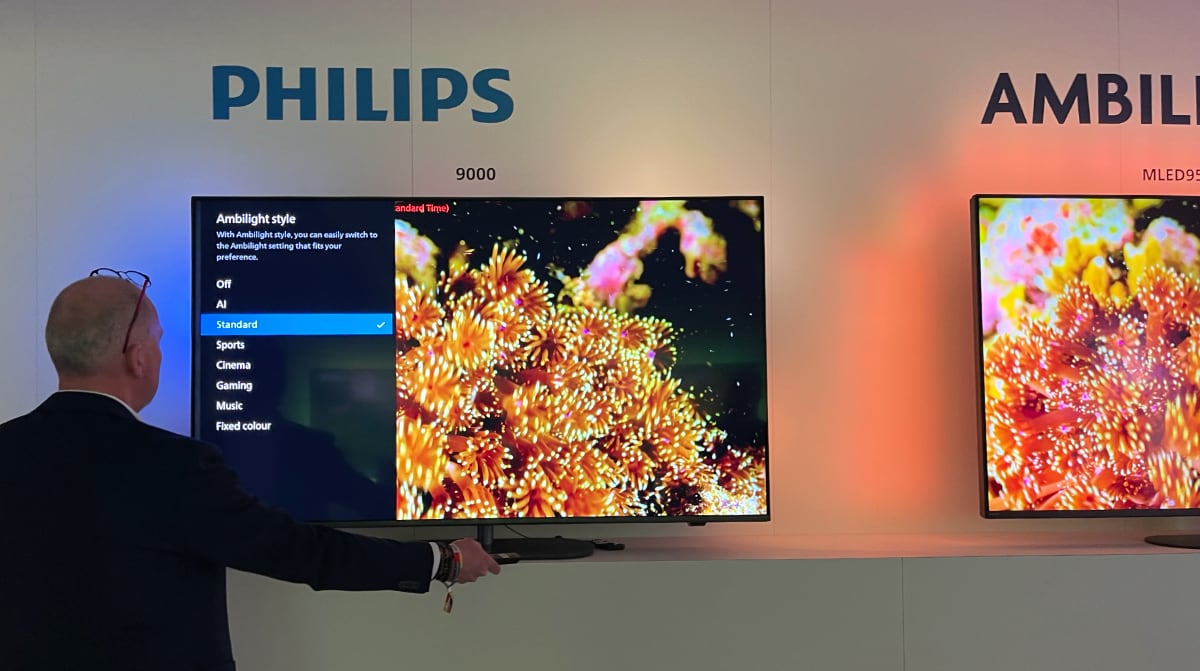
Ambilight off, Ambilight on. Photo: FlatpanelsHD
Only the OLED950, OLED910 and OLED860 ranges will run Google TV this year, and Philips will for the first time ship them with Android 14.
On the other hand, the MediaTek Pentonic 1000 chipset still limits these TVs to two HDMI 2.1 ports. While there is a Pentonic 800 to succeed the Pentonic 700, there is still no successor to the Pentonic 1000 ready to ship and it is too early to talk about HDMI 2.2 in TVs, Danny Tack told us.
As for the new miniLED LCD TVs, Philips would not disclose the number of miniLED dimming zones other than saying that MLED950 has "a lot more zones than last year" while MLED910 is the same. All 2025 miniLED ranges use VA LCD panels. However, the miniLED LCD models will not match the peak brightness of the Philips OLED860, let alone OLED950 and OLED910.
Philips' other TV platform, Titan OS, will get faster this year but most notably gain a new gaming hub where games from cloud gaming services are aggregated on a unified homescreen for easy access and discovery. Here's what it looks like. Titan OS currently supports Blacknut and Boosteroid, which also provides access to Xbox games.
At this time, there is no timeframe for bringing the Nvidia GeForce Now and Xbox apps to Titan OS. The team added that the gaming hub currently supports up to four Bluetooth game controllers and one Bluetooth headset at the same time.
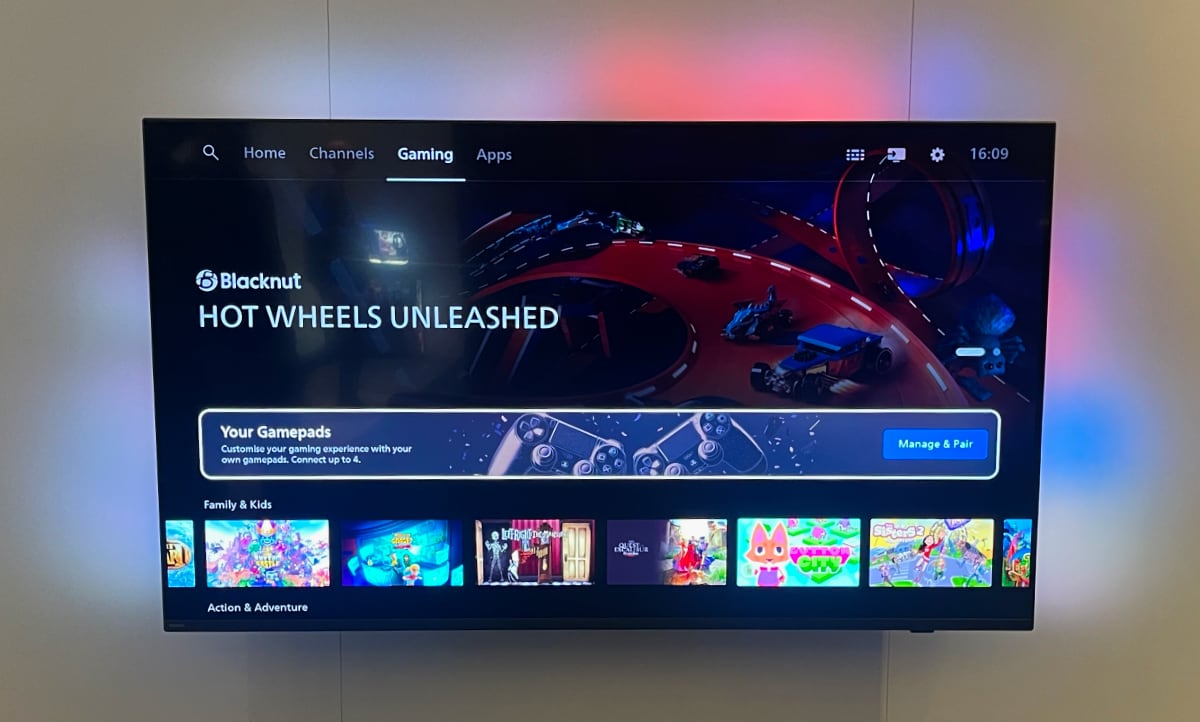
Titan OS has gained a new gaming hub that aggregates cloud gaming titles. Photo: FlatpanelsHD
The new Moments app
A new app called Moments will soon be released for Android and iOS mobile devices to let users create 'moments' – slideshows – to show on the TV. Once paired, the TV will wirelessly sync with the app on your smartphone, and the slideshows will continue to show on the TV even if you exit the mobile app.
The Moments app is compatible with 2025 Google TV and Titan OS models, and Philips is looking into expanding it to 2024 models.
Only the OLED910 will feature Bowers & Wilkins speakers this year. It still supports a wired subwoofer via the jack audio port.

The new Moments app will let you pick photos to show on your TV via a smartphone app. Photo: FlatpanelsHD
2026 audio technology
Lastly, Philips gave us a little teaser for audio technology in future TVs. The company's team working with AI technology is currently developing a new AI-based content detection system for sound adaptation and enhancement.
The plan is to introduce 'dual audio volume' adjustments to let the user control dialog volume independently of overall volume. Philips is hoping to introduce the technology with its 2026 TV line-up.
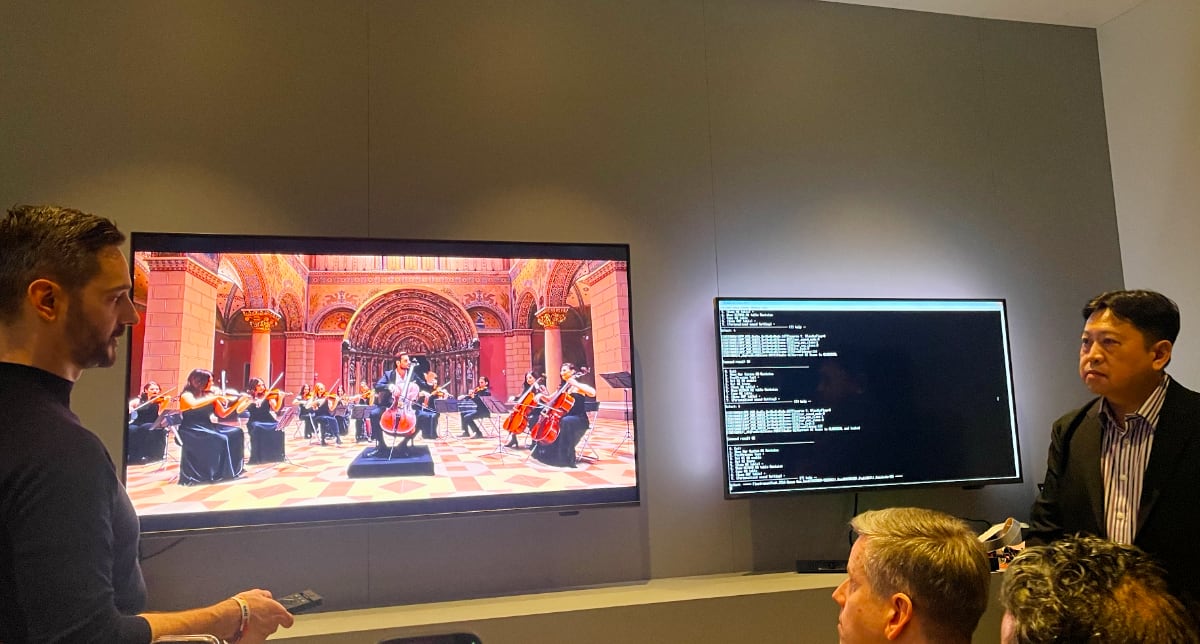
Philips teases dual audio volume for 2026, with the right TV showing the AI-based content recognition in real time. Photo: FlatpanelsHD

